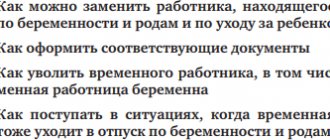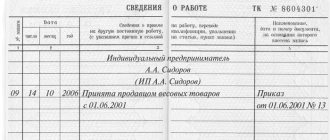Common mistakes
Typically, erroneous information appears for objective reasons (change of surname due to marriage, reinstatement of an employee by court decision) or due to the inattention of the specialist who fills out the document. Most often you can notice:
- incorrect indication of the worker’s first, patronymic and last name on the title page;
- incorrect dates of hiring, transfer to a new position, dismissal;
- inaccurate job title;
- missing letters, grammatical errors.
Since even one wrong character can cause a dispute when an employee goes to apply for a pension, personnel officers must be extremely careful. You should always check with the employee’s other documents - passport, birth certificate, marriage certificate, education diploma. And if an inaccuracy does creep in, it must be corrected correctly.
Sophia or Sophia
The first inaccuracies may already appear on the title page. A complex surname, national name or the possibility of variable spelling - it’s not difficult to make a mistake. Be extremely careful, do not be lazy to check the employment record with other employee documents. A difference even in one letter can become a reason to challenge the length of service in the Pension Fund.
If you yourself made a mistake when initially filling out your work book, take a new form and fill it out again. The damaged form is written off in the presence of the employee with the obligatory drawing up of a report.
But what if the incorrect entry was made a long time ago by one of the previous employers? Unfortunately, neither the Rules nor the Instructions regulate this situation in any way. In part, in resolving the issue, one can rely on the Decree of the Government of the Russian Federation of July 24, 2002 No. 555 “On approval of the Rules for calculating and confirming the insurance period for establishing labor pensions” and the Rules for calculating and confirming the insurance period for determining the amount of benefits for temporary disability, pregnancy and childbirth, approved by order of the Ministry of Health and Social Development of Russia dated February 6, 2007 No. 91.
These documents state that the ownership of a document to a specific person “is established on the basis of a marriage certificate, a certificate of change of name, certificates from competent authorities (officials) of foreign states or in court.” Technically, it looks as if we were entering the employee’s new surname, received in marriage: we carefully cross out the erroneous entry, and enter the correct one next to it. The document on the basis of which you are correcting the data must be indicated on the inside cover, certified by the seal and signature of the responsible person.
Kontur-Personnel keeps records of all types of seniority and instantly calculates the employee’s seniority as of any date.
Try for free
Changes and corrections in labor: how to do it correctly
In accordance with Section III of Government Decree No. 225, the employer may correct:
- surname, first name, patronymic;
- date of birth;
- information about education;
- name of the employee’s profession or specialty;
- information about awards.
The main rule of the personnel officer when correcting erroneously entered information is no crossing out. This is only permissible when correcting incorrect information on the title page. In other cases, changes are made by recognizing certain entries as inaccurate and making correct ones. In this case, the new data must be certified by the signature of the responsible person and, if available, the seal of the organization or personnel service.
Clause 1.2 of Resolution of the Ministry of Labor of Russia No. 69 specifies exactly how amendments should be made. Here is an example algorithm:
- Indicate the serial number.
- Enter the current date (day, month, year).
- In the next column, write down exactly what information is not true and what it should be replaced with.
- In the last column, indicate the details of the order or document on the basis of which the correction is made.
Please note: this algorithm is relevant for correcting information not only about labor documents, but also about inserts for them.
Sample correction in the work book 2020
How to correct an error or incorrect entry in a work book
If an error is made in the sections that record information about the specialist’s places of work and his awards, nothing can be crossed out (clause 12 of the Rules).
Correction in this case will be made by declaring the previously made entry invalid (by making a new separate entry of the corresponding content in the book) with the subsequent indication of current information.
Important! The correction can be made by the personnel officer not only of the company where the error was made, but also of the company that identified it, if the employee now works on its staff. In this case, it is necessary to have an official supporting document from the organization that made such a mistake.
This procedure for correcting errors is applied in most cases: if the name of the company, the position of a specialist, the department/department in which he worked, etc. were incorrectly indicated. And also in cases where a record of transfer/dismissal was made in the book, subsequently declared illegal.
For more information on how to invalidate an entry, see the article “Deeming an entry in a work book invalid - sample .
Making corrections to entries previously made by another company
Option 1. Correct for another organization
Based on the relevant documents, the employer who discovered or made an inaccuracy himself can correct any section in the work book. An employee is not required to go to the company where he previously worked to correct incorrect data. Moreover, sometimes this is simply impossible. At the request of the worker, changes are made by the responsible person of the organization where he is currently employed.
What documents can confirm the correction of erroneous information? It all depends on the situation. This could be a certificate from the archive, a court decision, or a copy of the document confirming the basis for correcting the data, confirmed by the previous employer. Witness testimony in this case has no legal force.
Option 2. The employee turns to the previous employer for correction.
If a person finds incorrect information in the Labor Code, he can contact his previous employer with a request to correct it. If he is already employed, then he writes an application with a request to give him a work book in order to make corrections to it. Then he brings the document to the human resources department of his previous employer, where he must correct the inaccuracies.
If a person does not have a new job, after the lines with information about dismissal, the former employer writes which entry is considered invalid.
If the ex-employee has already found a job, and new entries have appeared in his employment record, the former employer follows the following algorithm:
- Writes the name of the company.
- Indicates the next entry sequence number and date.
- In column 3, he clarifies which information is incorrect and enters the correct information.
- In the last column enters the details of the base document.
How to record a resignation
The rules for recording the dismissal of employees are prescribed in the instructions from the Ministry of Labor Resolution No. 69 of October 10, 2003 (hereinafter referred to as Instruction No. 69). They are:
- Column 1 contains the serial number of the entry;
- in column 2 - date of dismissal;
- in column 3 a record of dismissal is made indicating the reason;
- Column 4 provides a reference to the basis (dismissal order).
The main question that usually concerns HR specialists in this regard is what wording should be used to record a dismissal? Is it correct to write “fired” or “employment contract terminated” ?
If you refer to instruction No. 69, you will get the impression that it is correct to use the wording “dismissed” . These are the examples given in paragraph 5 of the instructions :
- dismissed due to staff reduction;
- dismissed due to liquidation;
- dismissed at his own request;
- dismissed due to non-election to a position, and so on.
However, it would be wrong to rely on the wording given in the instructions, and here’s why. The fact is that this document was adopted back in 2003 and has remained virtually unchanged since then. The Ministry of Labor has been working on new rules for maintaining labor records for a long time, and, apparently, that is why it is in no hurry to update the old resolution.
Meanwhile, Instruction No. 69 contradicts the rules of Article 84.1 of the Labor Code . This rule requires that in the dismissal record reference is made not only to the article of the law and the paragraph on the basis of which the employee is dismissed, but also to the part, that is, to a specific paragraph . However, in the current instruction No. 69, as an example, entries are given that do not contain references to part of the article (only its number and paragraph are indicated). It turns out that if the employer indicates the wording from the instructions in the work book, the rules of the Labor Code of the Russian Federation will be violated.
What to do in such a situation? The answer is given in the mentioned article 84.1 of the Labor Code of the Russian Federation. Its paragraph 5 requires that a record of the reasons and grounds for dismissal be made in strict accordance with the Labor Code or other law on the basis of which this dismissal is made. Therefore, a rule from legal practice is applied here, the essence of which is as follows: if 2 normative acts conflict, then the norms from the higher document are applied . In this case, it is the Labor Code.
Thus, it turns out that a more correct entry would be about the termination or termination of the employment contract . Moreover, there is a very specific difference between these two expressions, and it is as follows:
- if there is an initiative of the employee or employer to end the employment relationship, then the contract is terminated;
- if there is no such initiative, that is, the employment relationship is terminated due to circumstances beyond the control of the parties, then we are talking about termination of the employment contract (for example, Articles 83, 79 of the Labor Code of the Russian Federation).
If in doubt, you can open the article of the Code that describes the circumstances of dismissal and take the wording from it. If we consider typical reasons for dismissal , the wording is as follows:
- by agreement of the parties or at their own request, the employment contract is terminated;
- If the contract was fixed-term, then upon expiration of this period it is terminated.
Nevertheless, the wording “ fired ” is also used today, and it has its supporters. Moreover, this is precisely the option that logic dictates. After all, when an employee joins a company, the entry “accepted” , and not “the employment contract is concluded.” And since the initial entry in the book reflects the process that occurs with the employee, it is quite logical that the final entry should be made in the appropriate wording. That is, the employee is hired - the employee is fired.
However, the requirements of regulations do not always correspond to the laws of logic. Therefore, in order to avoid unnecessary questions and doubts, experts recommend focusing on the letter of the law. This means that it is safer to use language regarding termination/termination of the employment contract . An example of a recording can be seen in the image below.
How to record an employee's resignation
About signatures
So, the employee quits, and the employer must put an end to the employment relationship with him. This capacity is represented by the signatures of the parties and the seal of the organization (IP), if used.
On the employer’s side, the signature is placed by the director of the organization, individual entrepreneur or specialist responsible for maintaining the labor code. This can be either a personnel inspector or another employee whose responsibilities include maintaining work records, for example, an office manager or accountant.
The employee also puts his signature, thereby confirming the information about his dismissal. He should not make any additional entries (“acquainted”, etc.).
Corrections on the title page
All incorrect information on the title page is simply crossed out. The exact version, certified by signature and seal, is indicated next to it. This applies to cases where an employee has changed personal data, as well as situations where an error was made due to the inattention of the person who filled out the document.
It is recommended that the correction of the full name. employee on the title page was made by the employer who created the work book. Because only he can know exactly in whose name he issued this document. To avoid problems with assigning someone else’s labor code, the employee should be sent to the very first employer. If the company is liquidated or refuses to correct inaccuracies, the employee can go to court and demand that this work book belong to him.
If you need to indicate a new specialty or additional education on the title page, you do not need to cross out anything. In this case, put a comma in the required line and write new data.
Letter of the law
We talked in detail about the rules for filling out work books in the article “The letter of the law: each in its place.” Here we just recall that for a personnel officer the main documents in this matter are:
- Rules for maintaining and storing work books, producing work book forms and providing them to employers, approved by Decree of the Government of the Russian Federation of April 16, 2003 No. 225 “On work books” (hereinafter referred to as the Rules);
- Instructions for filling out work books, approved by Decree of the Ministry of Labor of Russia dated October 10, 2003 No. 69 (hereinafter referred to as the Instructions).
They are the ones who regulate how to draw up a work book, make changes, including correcting mistakes. In addition, there are a number of additional regulations that address more specific cases.
Errors in award information
For most employees, this section is empty, since this place contains information about awarded diplomas, certificates, titles, and other awards. Therefore, awards pages often end up with unnecessary information. In this case, the responsible person recognizes the entries as invalid, signs, puts a seal (if any) - in general, acts according to the general rules.
You must act in the same way if there is an inaccuracy in the dates, details of the foundation document, company name, or other data.
Changing personal data
The most common corrections in the title section are a change in the employee’s surname due to official marriage or a change in education/profession information.
Keep in mind: The information about the employee entered by the employer (full name, date of birth) must be thoroughly checked by the owner of the book and certified by his signature on the title page.
Changing personal data (last name, first name or patronymic) is carried out as follows:
- the original entry to be corrected is crossed out with a single line so that it remains readable, and the new value is written on top;
- on the left side of the spread (inside cover) the details (number and date) of the base document are indicated and the type of change made is entered;
- the record is certified by the signature of a personnel service employee and a seal.
Justifications may include documents issued by the registry office and recording a change in the employee’s civil status (marriage/divorce certificate, birth certificate, change of last name/first name/patronymic) or other official papers.
Do spelling errors need to be corrected?
Spelling errors are usually caused by inattention. If a letter is missing or mixed up in the termination information, no one will probably notice. But when a spelling error occurs in a specialty, a company name, or an appointment record, it can be costly for the employee. If, when assigning a pension, Pension Fund employees find fault with a “typo,” the employee will have to prove the right to state pension provision and length of service in court.
The main rule
The main rule of the personnel officer when correcting erroneously entered information: in sections containing information about work and awards, crossing out is prohibited (clause 30 of Resolution No. 225). Remember: you can only cross out on the title page. In other cases, the only possible option is to invalidate the entry and then make a new, correct entry.
New data must be certified by the signature of the responsible person and, if available, the seal of the organization or personnel service.
What documents can be used to confirm the correction of erroneous information depends on the situation. This could be a certificate from the archive, a court decision, a copy of the document that provides the basis for correcting the data, confirmed by the previous employer.
But witness testimony has no legal force.
Correction of dates and details
Incorrect dates are the same errors as the rest. There is no special way to clarify data for them. Therefore, a record where there is an inaccuracy is invalidated, and then the information with the correct dates is recorded.
HR officers often write incorrect document details. Such clerical errors are corrected according to the same rules: the entry is declared invalid, and then the data is rewritten without errors.
If there are several inaccuracies, each one must be corrected. If they are contained in dates, job titles, information about orders, then the personnel officer makes entries recognizing each of the incorrect formulations as invalid. Then indicates the correct data. It is also possible to correct several erroneous entries with one entry.
Remember that spelling errors also need to be corrected. Especially if there is a spelling error in the specialty, company name, or employment record. Such a “slip” can be costly for an employee. If, when assigning a pension, Pension Fund employees find fault with it, the employee will have to prove the right to length of service and pension in court.
General algorithm of actions
As a rule, they operate according to this algorithm.
- In the “Record No.” column, after the last record in this section, indicate the next serial number.
- Column 2 indicates the date on which the erroneous entry is invalidated. That is, the date when corrections are made (day, month - two-digit numbers, year - four-digit numbers).
- In column 3, first write “Record No. ___ is invalid.” Next, make the correct entry.
- Column 4 indicates the number and date of the document on the basis of which the correct data is entered. This may be the date and number of the order (instruction) or other decision of the employer, the entry from which was incorrectly entered into the work book, or the date and number of the document on the basis of which the correct entry was made.
How can I correct the name of the organization? After all, it does not have a serial number. When correcting, you need to link the title record with the employment record, which already has a serial number. That is, in column 3 they write: “The name of the organization and the entry for No. so and so shall be considered invalid,” and then in this column they write the correct name of the organization and the entry about admission again.
When entering information about the employer into the work book, you can use a stamp: this does not contradict current legislation. According to Rostrud, the stamp is equivalent to an entry in the work book. In this case, it is necessary that the full and, if available, abbreviated name of the organization is indicated on it (letter of Rostrud dated August 19, 2015 No. 1922-6-1).
There are also unusual cases. Thus, the Ministry of Labor of the Russian Federation, in a letter dated November 1, 2021 No. 14-0/B-868, reviewed the situation.
The organization discovered that in the employee’s work book, the previous employer entered the name of the organization using a stamp, but one word from the name was not readable in the stamp. Is it possible to fill in the missing word?
Please note that a stamp with the name of the organization is equivalent to an entry in the work book if it contains the full and abbreviated (if any) name of the organization (clause 3.1 of the Instructions).
But in order to correct an error caused by an unclear print, you should not add the missing text to it.
Simply, recognizing this entry as invalid, in column 3 of the “Information about work” section you need to write: “The stamp imprint with the name of the organization such and such and the entry for No. such and such shall be considered invalid.” And everything else is done in the general order.
Filling out a work book for someone hired for the first time
Until December 31, 2021, the employer was obliged to issue a work book to a person who was hired for the first time within a week from the date of employment (clause 8 of the Rules). However, as of January 1, 2021, these provisions do not apply. According to paragraph 8 of Article 2 of the Federal Law of December 16, 2019 No. 439-FZ, work books for persons entering work for the first time after December 31, 2020 are not issued. All information about the work activities of such employees is generated exclusively in electronic form.
Draw up and print an employment contract
Invalidation of an entry
The main and most common way to correct inaccuracies in work book entries is to invalidate the erroneous data. Let's look at the procedure for such correction using an example.
In the section of the work book under serial number 14 there is a record of the dismissal of employee Stepanenko O.O. from 10/21/2015, made on the basis of order No. 121-k and a statement of resignation at his own request.
On the morning of October 21, 2015, the manager filled out the work book and prepared all the documents necessary for dismissal, but Stepanenko O.O. withdrew her application and decided to continue working in the organization. To cancel a dismissal record, the manager must take the following actions:
- Issue a new order that cancels the dismissal order (for example, No. 122-k).
- Make a new entry dated 10/21/2015 in the work book under serial number 15 of the following type: “Entry number 14 is invalid.”
- After the entry, indicate the date and number of the new order, on the basis of which the previous entry is invalidated (in this case, this is order No. 122-k dated October 21, 2015).
If the correction of the entry concerns another issue (for example, the employee’s position is incorrectly indicated), then in the second paragraph, after indicating the number of the invalid entry, you must also enter the correct data.
Sample of cancellation of an entry in an employee’s work book











